
A Lazy Day for Canadians
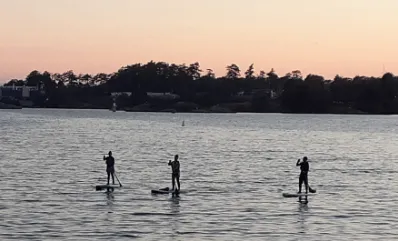
September 7, 2020 - Labour Day – A Lazy Day for Canadians
Labour Day in Canada is celebrated on the first Monday of September and it is a federal statutory holiday. This gives everyone in Canada a three-day weekend to enjoy life! This holiday officially celebrates workers and the labour union movement and unofficially the first day of fall (autumn).
The people of Canada love the fall weather with nice warm days and cool evenings. You will find SUP enthusiasts (stand up paddleboarders), kayakers, hikers, campers, and families having a picnic.
A great work-life balance is very important to Canadians!

MCCQE Part 1 Scheduling is Now Open for the January/February 2021 Session
The Medical Council of Canada released the following information on August 20, 2020:
Scheduling for the Medical Council of Canada Qualifying Examination (MCCQE) Part I for the January/February 2021 session is now available through our vendor Prometric. Please note that the MCCQE Part I will be offered through Prometric at available test centres or via remote proctoring, a new delivery model for the Medical Council of Canada (MCC). Recommended physical distancing and other personal protective measures are in place, as per the guidelines set by local public health authorities. Please select the modality that is most appropriate for your individual circumstances.
Application to the MCCQE Part I is offered on a continuous basis. If your application was submitted and accepted prior to scheduling being available, you will receive a message through your physiciansapply.ca account that will include instructions on how to schedule your exam appointment with Prometric. If you apply after scheduling opens, scheduling will be available to you as soon as your application is accepted.
One of Canada’s most wonderful features is the abundance of wildlife. This month we look at some of the tiniest and some of the largest.
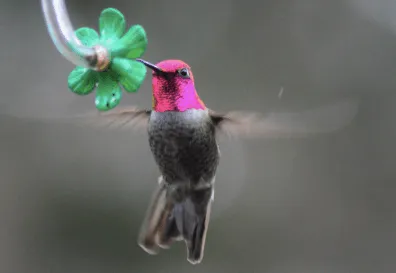
Hummingbirds: The Canadian Wildlife Federation writes, “There’s nothing quite like the thrill of seeing a hummingbird zipping through your garden. Hummingbirds are a marvel to watch as they hover in place or dart quickly among the plants. Despite their tiny size they’re quite feisty little creatures. And their bright jewel-like colours, especially those of males, add a brilliant dimension to any scene. Attracting them to your garden can be very rewarding.
There are five species of hummingbird found in Canada. The ruby-throated hummingbird is the most widespread, found from Alberta east to Nova Scotia. The calliope hummingbird is the tiniest of the five, and is found in central interior British Columbia and southwestern Alberta. Anna’s hummingbird can be found in parts of southern British Columbia and Vancouver Island, while the black-chinned hummingbird can make its way up the interior of southern British Columbia. The rufous hummingbird, considered to have the longest known avian migration, has a slightly wider distribution. It can be found in southwestern Yukon, most of British Columbia and southwestern Alberta.”
The migration patterns are different for all species. For example, the ruby-throated hummingbird will migrate to Mexico and Central American for the winter. The males left in July, the females in August and the immature leave in September. Anna’s Hummingbirds don’t migrate except for short distances to find better feeding grounds.
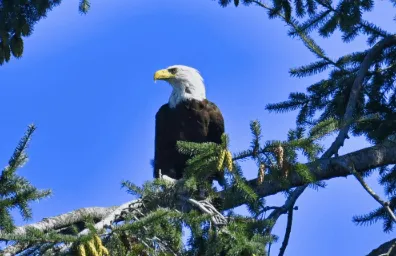
Bald Eagles: Most of Canada’s bald eagle population is found along the Pacific coast of British Columbia. Healthy eagle populations are also found in the boreal forests of Alberta, Saskatchewan, Manitoba and northwestern Ontario.
Bald eagles make their homes in forested areas near large bodies of water. This environment ensures good fishing and large trees for nesting. Eagles prefer areas that are isolated from humans.
The bald eagle is the only eagle exclusive to North America. They are at the top of the food chain and have few natural enemies. When bald eagle populations dwindle, it’s likely because humans have interfered with their natural habitat. – extract from Canadian Geographic
It is actually very easy to spot bald eagles as you visit these areas. Often you will see them from the roadside in remote areas, beside rivers as you hike, or while out boating.
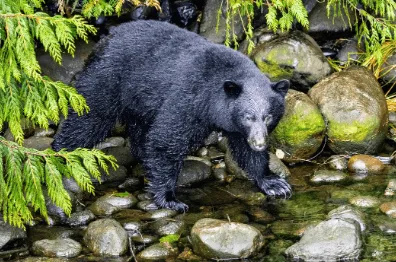
Black Bear: In Canada, about 500,000 black bears inhabit forested areas and they have adapted to thrive in landscapes with some level of human activity. Canada has effectively managed black bears under the sustainable resource management approach advocated by all international conservation agencies and conventions, including the IUCN (World Conservation Union). Canada fully supports conservation controls on international trade.
Most North American jurisdictions have invested tremendous amounts of human and financial resources to implement ‘Bear Smart’, ‘Bear Aware’ or ‘Bear Wise’ programs to educate people on what can be done to deter bears from associating people and dwellings with food.
If you encounter a wild black bear there are numerous recommendations. Google “Staying Safe in Bear Country” for the recommendations suited to your area. Be careful when driving as well. Just a week ago we were driving, and a black bear ran out from the side of the road in front of the car. They move very fast. So, beware on remote roads!
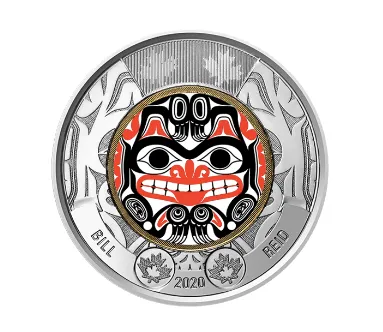
Haida Art by famous artist Bill Reid is on Canada’s two-dollar coin. The first coin to have colour.
Haida Art
Haida Art is one of British Columbia’s treasures. The history of the First Nations people and their art are highly respected by Canadians.
This art is recognized around the world for its monumental totem poles and sculptures; fine carving in wood, metal and slate; and weaving. Through countless generations, Haida artists have developed a system of design, which they apply to both sculptural forms and two-dimensional art. It is this system, including the treatment of line and the use of recurring design elements that distinguishes Haida art.
The ocean is a profound source of inspiration for Haida art. Many of the creatures found on family crest poles and other carved objects are drawn from the ocean. Killer whales, sea lions, halibut, sharks and supernatural beings such as the Sea-wolf are some of these beings of the sea that Haida artists depict.
There is no word for “art” in the Haida language. Art is integrated into the fabric of community life and sustained by the special resources of Haida Gwaii: cedar to carve poles, canoes and masks; cedar bark and spruce roots to make hats; and shells to adorn button blankets and masks.
Art is found in an intricate carving of an octopus on a fish hook or in a feast dish carved to represent a halibut. Art is one with ceremony when family crest poles are raised, masks are brought to life through dance, and button blankets bearing clan crests are worn.
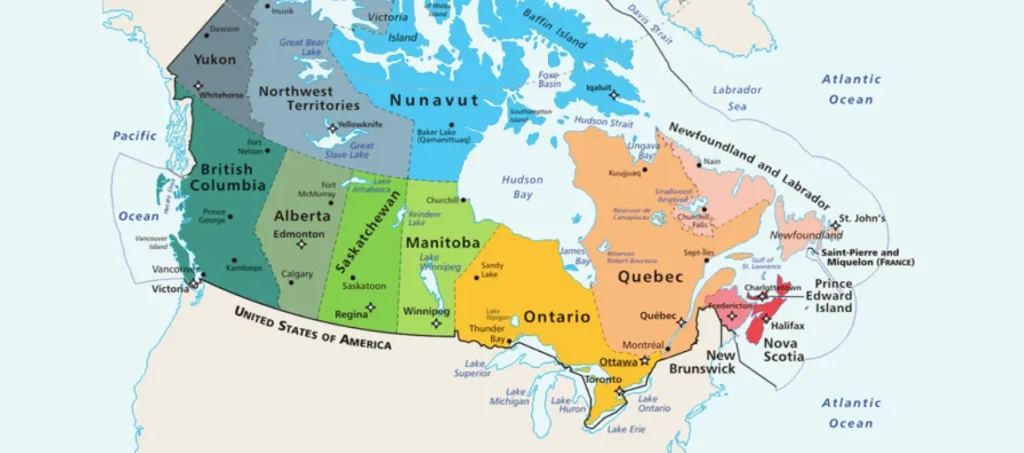
This Month’s Geography Lesson – New Brunswick
Practicing as a GP in New Brunswick is very similar to practicing in the UK, Ireland, Australia or the USA. Standards are very high. Your income will be considerably higher than in the UK.
Holidays are a big part of life here. In most clinics you are compensated on a fee-for-service basis which essentially means your income is determined by how many patients you see. So, if you decide to make holidays a priority your income will be less. Most people in New Brunswick put a high value their time off and enjoy life with their families.
New Brunswick (French: Nouveau-Brunswick) is one of four Atlantic provinces on the east coast of Canada. According to the Constitution of Canada, New Brunswick is the only bilingual province. About two-thirds of the population declare themselves anglophones and one-third francophones. One-third of the population describes themselves as bilingual. Atypically for Canada, only about half of the population lives in urban areas, mostly in Greater Moncton, Greater Saint John and the capital Fredericton.
Unlike the other Maritime provinces, New Brunswick’s terrain is mostly forested uplands and much of the land is further from the coast, giving it a harsher climate. New Brunswick is 83% forested and less densely populated than the rest of the Maritimes.
Being relatively close to Europe, New Brunswick was among the first places in North America to be explored and settled by Europeans.
In the latest census, the most commonly reported ethnicities were British 40%, French Canadian and Acadian 31%, Irish 18%, other European 7%, First Nations 3%, Asian Canadian 2%.
The value of exports, mostly to the United States, was $1.6 billion in 2016. About half of that came from lobster. Other products include salmon, crab, and herring.
New Brunswick is a beautiful and peaceful place to practice medicine as a general practitioner. You can achieve the work-life balance you are seeking.
CanadaMedicalCareers.ca has several outstanding openings for GP’s in New Brunswick. Email [email protected] for more details.

MRCGP and Family Practice Exams in Canada
The College of Family Physicians of Canada is the recognized licensing authority for family physicians in Canada. Those physicians coming from the UK, Ireland, Australia, or the USA will usually not have to write the examination required to practice as a General Practitioner in Canada. Verification of your MRCGP, MICGP, FRACGP, FACRRM, or DABFM will be required. For more information on this certification visit CFPC.ca and check out the Education and Professional Development section. Members in good standing will use the CCFP certification.

PhysiciansApply.ca
If you are serious about practicing medicine in Canada the first thing you should do is open an account with PhysiciansApply.ca. It is an online portal operated under the auspices of the Medical Council of Canada (similar to the GMC in the UK). Every doctor coming to Canada must have an account. This is where your credentials must be verified. These credentials include your passport, medical degrees and more. Every province and territory of Canada has a regulatory authority to handle physician licensing and these authorities (Colleges) will need to access your PhysiciansApply.ca account before you can be licensed in Canada.
Don’t wait! Some documents can be verified quickly, and others may take some time, especially if you attended medical school in a country that is slow to respond to inquiries from Canada.
If you are an IMG, licensing in Canada as a physician simply does not happen without a PhysiciansApply.ca account.
We like questions!
It’s likely that you will have questions along your journey to practicing in Canada. Don’t hesitate to contact John Livingstone at: [email protected]